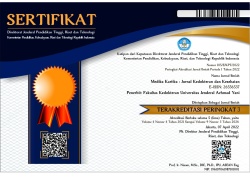PROTOZOA OPORTUNISTIK PENYEBAB ENSEFALITIS DAN KERATITIS: ACANTHAMOEBA
: Acanthamoeba
Abstract
Acanthamoeba merupakan kelompok protozoa free-living amoeba (FLA) yang dapat menimbulkan mortalitas tinggi terkait ensefalitis dan kebutaan karena keratitis. Infeksi Acanthamoeba pada manusia dari tahun ke tahun menunjukkan peningkatan jumlah kasus, khususnya sebagai keratitis. Patogenesis Acanthamoeba sebagai penyebab ensefalitis masih belum dipahami sepenuhnya namun, berdasarkan temuan histopatologi kemungkinan melalui jalur transendotelial, rete vasorum, maupun kombinasi keduanya. Patogenesis terjadinya keratitis oleh Acanthamoeba akibat infiltrasi pada epitel kornea hingga menembus stroma di bawahnya yang dapat menyebabkan kerusakan dan memicu peradangan hebat. Kemampuan Acanthamoeba untuk beradaptasi di lingkungan dan mengandung bakteri endosimbion memengaruhi patogenitas dan resistensi terhadap agen terapeutik. Penegakkan diagnosis melalui gambaran klinis didukung isolasi Acanthamoeba melalui pemeriksaan mikroskopis atau kultur atau molekuler yang cermat sangat penting untuk pemberian terapi sedini mungkin. Penatalaksanaan infeksi Acanthamoeba meliputi pemberian antimikroba kombinasi. Diagnosis dan terapi dini yang tepat dapat menurunkan angka morbiditas dan mortalitas akibat infeksi protozoa ini.
Kata kunci: Acanthamoeba, ensefalitis, free-living amoeba, keratitis
DOI : 10.35990/mk.v8n1.p82-94
References
2. Trabelsi H, Dendana F, Sellami A, Sellami H, Cheikhrouhou F, Neji S, et al. Pathogenic free-living amoebae: Epidemiology and clinical review. Pathol Biol. 2012;60(6):399–405.
3. Padzik M, Szaflik JP, Baltaza W, Perkowski K, Dybicz M, Chomicz L. In vivo confocal microscopy and in vitro culture techniques as tools for evaluation of severe Acanthamoeba keratitis incidents. Ann Parasitol. 2017;63(4):341–6.
4. Balczun C, Scheid PL. Free-living amoebae as hosts for and vectors of intracellular microorganisms with public health significance. viruses. 2017;9(4):65.
5. Salazar-Ardiles C, Asserella-Rebollo L, Andrade DC. Free-living amoebas in extreme environments: The true survival in our planet. Biomed Res Int. 2022;2022:2359883.
6. Attariani H, Turki H, Shoja S, Salahi-Moghaddam A, Ghanbarnejad A, Shamseddin J. Investigating the frequency of free-living amoeba in water resources with emphasis on Acanthamoeba in Bandar Abbas city, Hormozgan province, Iran in 2019-2020. BMC Res Notes. 2020;13(1):1–7.
7. Nageeb MM, Eldeek HEM, Attia RAH, Sakla AA, Alkhalil SS, Farrag HMM. Isolation and morphological and molecular characterization of waterborne free-living amoebae: Evidence of potentially pathogenic Acanthamoeba and Vahlkampfiidae in Assiut, Upper Egypt. PLoS One. 2022;17(7): e0267591.
8. Visvesvara GS, Schuster FL. Opportunistic free-living amebae, Part II. Clin Microbiol Newsl. 2008;30(21):159–66.
9. Rodriguez-Anaya LZ, Félix-Sastré ÁJ, Lares-Villa F, Lares-Jiménez LF, Gonzalez-Galaviz JR. Application of the omics sciences to the study of Naegleria fowleri, Acanthamoeba spp., and Balamuthia mandrillaris: Current status and future projections. Parasite. 2021;28:36.
10. Marciano-Cabral F, Cabral G. Acanthamoeba spp. as agents of disease in humans. Clin Microbiol Rev. 2003;16(2):273–307.
11. Zhang Y, Xu X, Wei Z, Cao K, Zhang Z, Liang Q. The global epidemiology and clinical diagnosis of Acanthamoeba keratitis. J Infect Public Health. 2023;16(6):841-852.
12. Haston JC, O’Laughlin K, Matteson K, Roy S, Qvarnstrom Y, Ali IKM, et al. The epidemiology and clinical features of non-keratitis Acanthamoeba infections in the United States, 1956–2020 . Open Forum Infect Dis. 2023;10(1):ofac682.
13. Putri D, Edwar L, Susiyanti M. Acanthamoeba keratitis in a non-contact lens wearer: A challenge in diagnosis and management. J Case Reports. 2015;4(2):419–23.
14. Muslim F, Sitompul R, Edwar L. Acanthamoeba keratitis: A challenge in diagnosis and the role of amniotic membrane transplant as an alternative therapy. Med J Indones. 2018;27(4) :523-34.
15. Gunawan PI, Idarto A, Saharso D. Acanthamoeba infection in a drowning child. Ethiop J Health Sci. 2016;26(3):289-92.
16. Wang Y, Jiang L, Zhao Y, Ju X, Wang L, Jin L, et al. Biological characteristics and pathogenicity of Acanthamoeba. Front Microbiol. 2023;14:1147077.
17. Chomicz L, Szaflik JP, Szostakowska B, Izdebska J, Baltaza W, Łazicka-Gałecka M, et al. Successive Acanthamoeba corneal isolates identified in Poland monitored in terms of in vitro dynamics. Microorg. 2023;11(5):1174.
18. Diehl MLN, Paes J, Rott MB. Genotype distribution of Acanthamoeba in keratitis: a systematic review. Parasitol Res. 2021;120(9):3051–63.
19. Kalra SK, Sharma P, Shyam K, Tejan N, Ghoshal U. Acanthamoeba and its pathogenic role in granulomatous amebic encephalitis. Exp Parasitol. 2020;208:107788.
20. Niederkorn JY. The biology of Acanthamoeba keratitis. Exp Eye Res. 2021;202:108365.
21. Rayamajhee B, Subedi D, Peguda HK, Willcox MD, Henriquez FL, Carnt N. A Systematic review of intracellular microorganisms within Acanthamoeba to understand potential impact for infection. Pathog. 2021;10(2):225.
22. Siddiqui R, Khan NA. Biology and pathogenesis of Acanthamoeba. Parasites and Vectors. 2012;5(1):1–13.
23. Mungroo MR, Siddiqui R, Khan NA. War of the microbial world: Acanthamoeba spp. interactions with microorganisms. Folia Microbiol. 2021;66(5):689–99.
24. Guimaraes AJ, Gomes KX, Cortines JR, Peralta JM, Peralta RHS. Acanthamoeba spp. as a universal host for pathogenic microorganisms: One bridge from environment to host virulence. Microbiol Res. 2016;193:30–8.
25. Iovieno A, Ledee DR, Miller D, Alfonso EC. Detection of bacterial endosymbionts in clinical Acanthamoeba isolates. Ophthalmology. 2010;117(3):445-52.
26. Bunsuwansakul C, Mahboob T, Hounkong K, Laohaprapanon S, Chitapornpan S, Jawjit S, et al. Acanthamoeba in southeast Asia – Overview and challenges. Korean J Parasitol. 2019;57(4):341–57.
27. Brindley N, Matin A, Khan NA. Acanthamoeba castellanii: High antibody prevalence in racially and ethnically diverse populations. Exp Parasitol. 2009;121(3):254-6.
28. Kot K, Łanocha-Arendarczyk N, Kosik-Bogacka D. Immunopathogenicity of Acanthamoeba spp. in the brain and lungs. Int J Mol Sci. 2021;22(3):1261.
29. Król-Turmińska K, Olender A. Human infections caused by free-living amoebae. Ann Agric Environ Med. 2017;24(2):254–60.
30. Baig AM, Khan NA. A proposed cascade of vascular events leading to granulomatous amoebic encephalitis. Microb Pathog. 2015;88:48–51.
31. Siddiqui R, Emes R, Elsheikha H, Khan NA. Area 51: How do Acanthamoeba invade the central nervous system? Trends Parasitol. 2011;27(5):185–9.
32. Baig AM. Pathogenesis of amoebic encephalitis: Are the amoebas being credited to an “inside job” done by the host immune response? Acta Trop. 2015;148:72–6.
33. da Rocha-Azevedo B, Tanowitz HB, Marciano-Cabral F. Diagnosis of infections caused by pathogenic free-living amoebae. Interdiscip Perspect Infect Dis. 2009;2009:1–14.
34. Lorenzo-Morales J, Khan NA, Walochnik J. An update on Acanthamoeba keratitis: Diagnosis, pathogenesis and treatment. Parasite. 2015;22:10.
35. Fanselow N, Sirajuddin N, Yin XT, Huang AJW, Stuart PM. Acanthamoeba keratitis, pathology, diagnosis and treatment. Pathogens. 2021;10(3):323.
36. Clarke DW, Niederkorn JY. The pathophysiology of Acanthamoeba keratitis. Trends Parasitol. 2006;22(4):175–80.
37. Szentmáry N, Daas L, Shi L, Laurik KL, Lepper S, Milioti G, et al. Acanthamoeba keratitis – Clinical signs, differential diagnosis and treatment. J Curr Ophthalmol. 2019;31(1):16–23.
38. Azzopardi M, Chong YJ, Ng B, Recchioni A, Logeswaran A, Ting DSJ. Diagnosis of Acanthamoeba keratitis: Past, Present and Future. Diagnostics (Basel). 2023;13(16):2655.
39. Singh P, Kochhar R, Vashishta RK, Khandelwal N, Prabhakar S, Mohindra S, et al. Amebic meningoencephalitis: Spectrum of imaging findings. Am J Neuroradiol. 2006;27(6):1217-21.
40. Sütçü M, Aktürk H, Gülümser-şişko S, Acar M, Erol OB, Somer A, et al. Granulomatous amebic encephalitis caused by Acanthamoeba in an immuncompetent child. Turk J Pediatr. 2018;60(3):340–3.
41. Schuster FL. Cultivation of pathogenic and opportunistic free-living amebas. Clin Microbiol Rev. 2002;15(3):342-54.
42. dos Santos DL, Virginio VG, Berté FK, Lorenzatto KR, Marinho DR, Kwitko S, et al. Clinical and molecular diagnosis of Acanthamoeba keratitis in contact lens wearers in southern Brazil reveals the presence of an endosymbiont. Parasitol Res. 2022;121(5) :1447-1454.



























